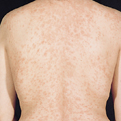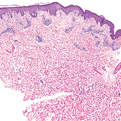Pityriasis Rosea
General Information
Pityriasis Rosea is a common cutaneous disease. Pityriasis rosea is characterized by an initial plaque (Herald Patch) located on the body, followed by a systemized eruption within one to two weeks. The primary patch (often misdiagnosed for eczema) is characterized as a single scaly red spot, usually located on the trunk of the body. The secondary rash occurs in crops following the lines of cleavage of the skin (Langer’s lines) resembling the branches of an evergreen tree. Pityriasis rosea is a self-limited condition resolving in around eight weeks. Treatment is essentially is to control any pruritus associated with the condition. Medications that healthcare providers may prescribe include zinc oxide, calamine lotion, topical steroids, oral antihistamines or oral steroids.
Epidemiology
Prevalence of 0.13% in men and 0.14% in women in the United States
Etiology
Unknown; Some research links viral or bacterial infection
Pathogenesis
Begins as a single patch “herald patch”, evolves into smaller patches around the body
Clinical
Herald patch (primary patch) is a 1-2 cm in diameter, light pink center with dark red peripheral zone. Secondary lesions resembles the primary patch on a smaller scale
Histology
Superficial perivascular infiltrate of lymphocytes, variable numbers of extravasated erythrocytes in an edematous papillary dermis, a slightly hyperplastic epidermis that houses foci of spongiosis, and mounds of parakeratosis.
Bibliography
1. “Pityriasis Rosea” (Online). October 2003. http://www.aad.org/public/publications/pamphlets/common_pityriasis.html (visited: April 1, 2008) 2. “Pityriasis Rosea” (Online). March 2008. http://www.emedicine.com/emerg/topic426.htm (visited: April 1, 2008)
Download PDF
![]() Pityriasis Rosea
Pityriasis Rosea


